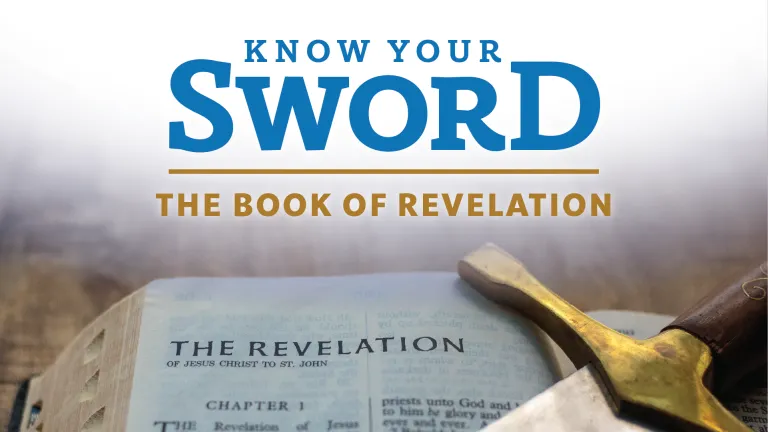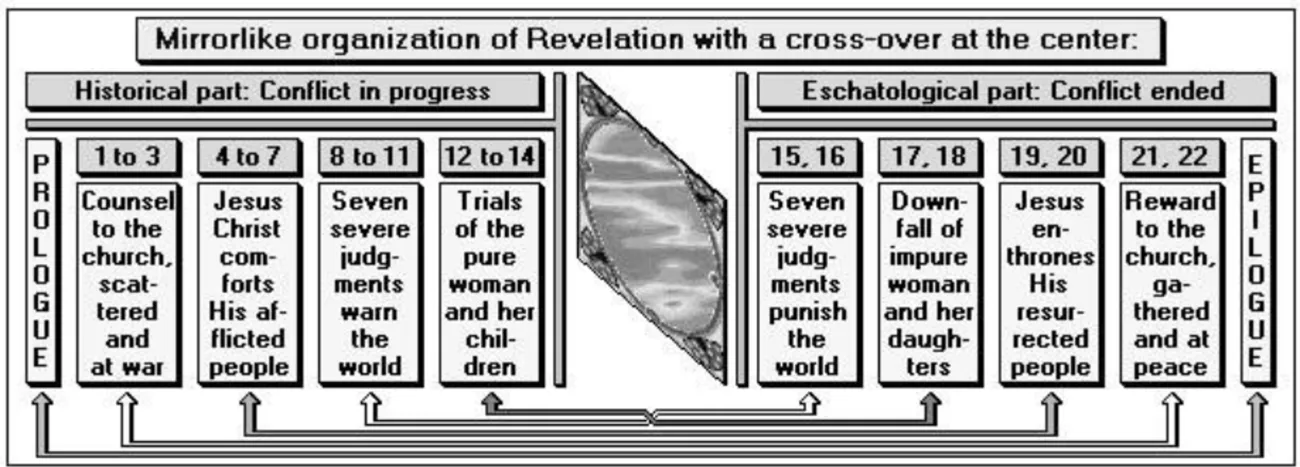Revelation Part 04

The chiastic structure appears throughout the Bible and serves as both an artistic and interpretive tool. In Revelation, it divides the book into eight main sections, each beginning with a heavenly scene and moving between symbolic and literal descriptions.
Another critical key to understanding Revelation is reminiscent of our high school English classes and involves recognizing the chiastic structure of the book. This is a literary pattern where the second half of the text mirrors the first (A-B-C-D-E-F-G-F-E-D-C-B-A). This structure appears throughout the Bible and serves as both an artistic and interpretive tool. It has been proposed that the Book of Daniel is composed of a double-chiasm emphasized by the two languages that the book is written in: Aramaic and Hebrew. The first chiasm is written in Aramaic from chapters 2-7 following an ABC...CBA pattern. The second chiasm is in Hebrew from chapters 8–12, also using the ABC...CBA pattern. The story of Noah is another great example of this literary pattern:
(A) Ark
(B) Living Creatures
(C) Food
(D) Animals
(E) Entering Ark
(F) Waters Increase
(G) God Remembers Noah
(F) Waters Decrease
(E) Exiting Ark
(D) Animals
(C) Food
(B) All Living Creatures
(A) Ark
The chiastic structure is an impressive literary accomplishment. Oral literature is especially rich in chiastic structure, possibly as an aid to memorization and oral performance. In Revelation, it divides the book into eight main sections, each beginning with a heavenly scene and moving between symbolic and literal descriptions. God inspired John to write in a way that aligns with other sections of the Bible and makes it clear that he did not “make it up.” The chiastic structure helps us interpret the language of the book by giving us something to compare to and helps us discern what is symbolic and what is literal.

This literary pattern can help readers discern which parts of Revelation are symbolic and which are likely literal, while also reinforcing the theological message: the conflict between God and Satan, and the eventual victory of Christ. The first half of the book has to do with Satan’s efforts to coerce and destroy God’s followers, and we see much of his success in the seven churches, seven seals, seven trumpets and especially with the symbolic beasts of chapters 12 and 13. The second half of the book has to do with God’s victory over evil, the 144,000, the gospel to the world, the defeat of Babylon, the second coming of Christ, the Millennium, and the new earth. (RevelationofJesus.net)
For example, looking at division 6, we see that it has two parts. The seven last plagues seem to be quite literal. “Men who had the mark of the beast” [broke out with] “foul and loathsome sores . . . they gnawed their tongues because of the pain. They blasphemed the God of heaven because of their pains and their sores” (Revelation 16:2,10,11). There is nothing about the sores that seem symbolic; all of the seven last plagues seem quite literal. But as division 6 continues in chapter 17 it becomes very symbolic with beasts, horns and a harlot with the name “Babylon the Great” on her forehead.
The chiastic pair of division 6 is division 3, the seven trumpet plagues in Revelation chapters 8 through 11. Because it is a mirror image of division 6, we would expect it also to have a literal section and a symbolic section. And it does have two sections that are quite different. In chapters 8 and 9, John saw “something like a mountain burning with fire [which] was thrown into the sea” (Revelation 8:8). He saw “hail and fire” that burned up a third of the trees, “locusts . . . [that looked] like horses prepared for battle,” and horses…with heads like lions; “and out of their mouths came fire, smoke, and brimstone” (Revelation 8:7, 9:7-11,17-19). These images have often been interpreted as highly symbolic, but their chiastic pairing with the seven last plagues suggests that John was giving a literal description of future events that were totally unfamiliar to him, and he tried to compare them with things he was familiar with from his time, such as burning mountains, locusts and horses.
In chapters 10 and 11 the scene shifts to a mighty angel standing over the water, a book that John had to eat, and two witnesses who were killed by a beast from the bottomless pit. Again, the chiastic pairing shows us that we are looking at highly symbolic scenes.
It is important to keep in mind that the chiastic structure is only one of several tools to help us understand Revelation. We will need to confirm the interpretations that are suggested by the chiasm with other evidence as well.
Ultimately, the structure of Revelation reveals that it is not random or chaotic, but divinely designed, aligned with the rest of Scripture, and written to inspire faith, hope and preparation for Christ’s return. The blessings promised to those who read and keep the words of the prophecy (Revelation 1:3) are deeply connected to understanding the book’s literary design, prophetic connections, and its role as the final word in God’s redemptive plan.
UYA Team | uya@ucg.org
United Young Adults (UYA) primarily serves the 18–32-year age group for the United Church of God. There are three main areas of contribution to the lives of the young adults: Promoting Spiritual Growth, Developing Meaningful Relationships and Making the Most of Your Talents. The Know Your Sword series is a daily expository message introducing God’s Word from a trusted perspective.

